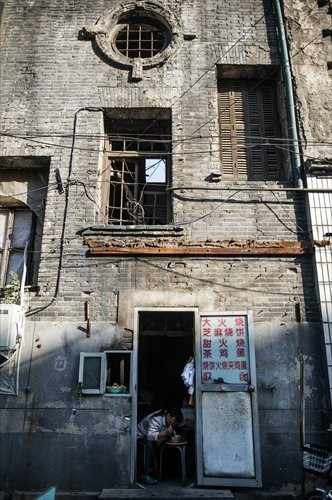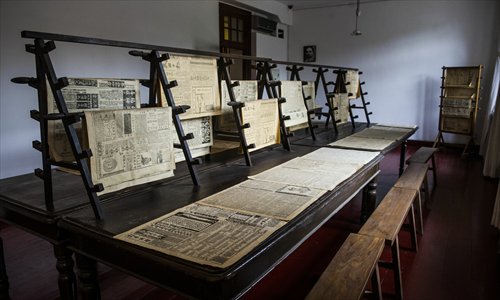

Residents eat at home in the Xiangchang New Quarter. Photo: Li Hao/GT

The newspaper reading room at the Beida Honglou, where Chairman Mao Zedong once worked as a librarian. Photo: Li Hao/GT
Relocating local residents has been a complicated task. Some are happy to leave and move into their new apartments, while others are reluctant to abandon the neighborhood they have called home for decades.
"As far as I know, this area is one of the poorest in downtown Beijing, and many of the residents actually want to improve their living standards by having new homes," said Li.
The three-storey Dongfang Hotel is one of the few standing reminders of the past, having endured turbulent times of World War II and the local area's recent modernization.
Built in 1918, it was the first private modern hotel in Beijing and the third modern hotel after the Beijing Hotel and Wagon-Lits Hotel run under French and English management respectively.
When Beijing fell under Japanese occupation during World War II, the hotel was converted into a base for pro-Tokyo spies. In the decade after the founding of the People's Republic of China in 1949, it became the main residence for foreign experts in China.
Challenges with revival
When the government announced its plan to reconstruct the Xiangchang New Quarter in May, local historic buildings were thrust into the public spotlight.
The area today is part of the Tianqiao Culture Reservation Zone, serving as a traditional folk culture hub with its teahouses, shadow puppet plays, dragon dances and Chinese wrestling.
However, public opinions are divided over whether the project will effectively reinvigorate the local community.
"Unlike siheyuan (residential compounds around a square courtyard) which are common in Beijing, the Xiangchang New Quarter was architecturally more like Shanghai's longtang (traditional urban alleys). It didn't suit Beijingers at that period," said Liu Yang, a council member of the Beijing Historical Geography and Folk Culture Association.
"The quarter is near Long Xugou, which was depicted in Lao She's literature as the poorest region before the liberation of Beijing. The local people were mostly from the lower class [in the early 20th century] and couldn't afford to live in such buildings," Liu added, describing it as a "vanity project" of its time.
Beida Honglou located at Wusi Dajie in Dongcheng district is a museum today displaying cultural relics, but from 1916 to 1952 it was the revolutionary heart of the campus of Peking University.
"See the wires installed on the top of the wall? They power the old building's air conditioners and other electronic appliances," Xin Yi, a heritage activist who lectures at a Beijing university she asked not to be named, told Metropolitan.
"The best option is to renovate old buildings in accordance to their original structures. We should try to reuse them rather than demolish them," she said. "Locals who have lived here for generations should be able to choose whether they want to stay or move out of their old homes. They fulfill an important part of the local culture."
Beijing-born photographer Liu Zheng, 32, has visited the Xiangchang New Quarter regularly over the past decade to record its changes.
Despite identifying himself as a heritage crusader, Liu Zheng is skeptical about the government's project, saying "it should have happened decades ago."
"The best way is to restore the buildings' original appearance, but now this is very hard because there is no one to carry out the classic craftsmanship in construction and decoration," he said.
The Qianmen Dajie project in 2006, which saw property developer SOHO China demolish sections of the ancient commercial street as part of its heritage revitalization, is still fresh in the minds of many Beijingers. When the new street was completed in 2008, Liu Zheng's grandmother, who grew up in the area, asked him to take her for a visit.
"She was heartbroken at seeing the renovated street," Liu recalled. "She didn't accept it at all because everything had changed, and she vowed never to return."
Copyright ©1999-2018
Chinanews.com. All rights reserved.
Reproduction in whole or in part without permission is prohibited.